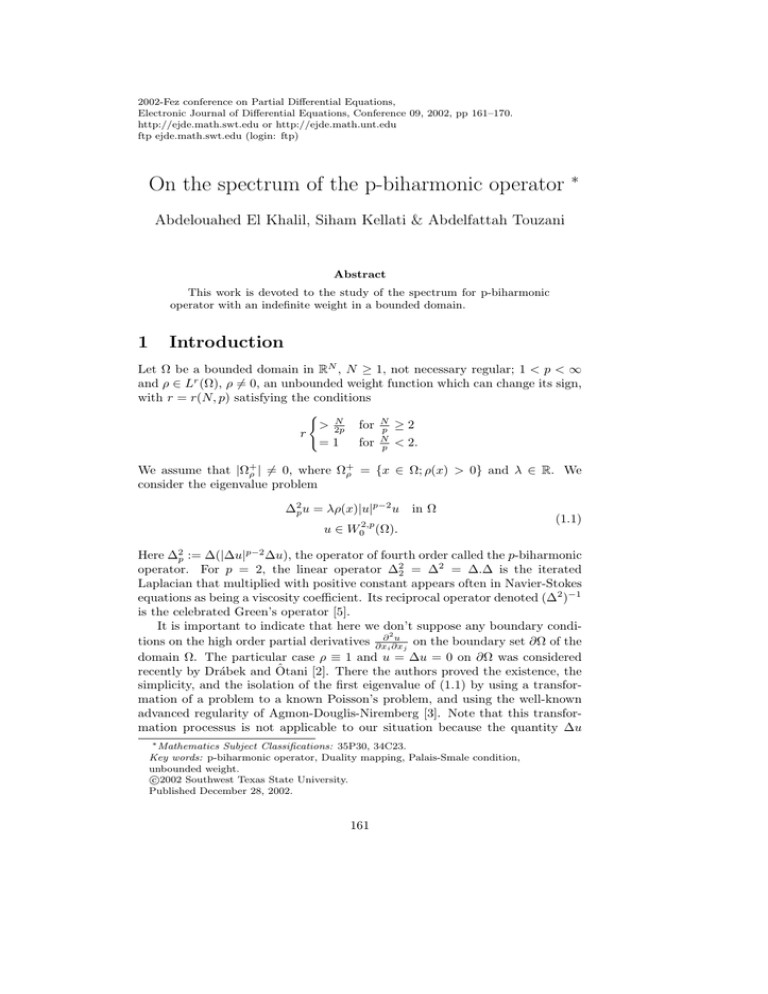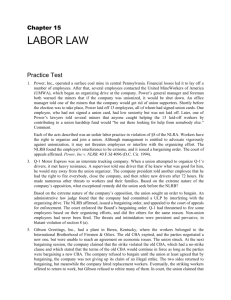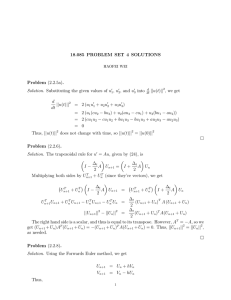Document 10767353
advertisement

2002-Fez conference on Partial Differential Equations,
Electronic Journal of Differential Equations, Conference 09, 2002, pp 161–170.
http://ejde.math.swt.edu or http://ejde.math.unt.edu
ftp ejde.math.swt.edu (login: ftp)
On the spectrum of the p-biharmonic operator
∗
Abdelouahed El Khalil, Siham Kellati & Abdelfattah Touzani
Abstract
This work is devoted to the study of the spectrum for p-biharmonic
operator with an indefinite weight in a bounded domain.
1
Introduction
Let Ω be a bounded domain in RN , N ≥ 1, not necessary regular; 1 < p < ∞
and ρ ∈ Lr (Ω), ρ 6= 0, an unbounded weight function which can change its sign,
with r = r(N, p) satisfying the conditions
(
N
for Np ≥ 2
> 2p
r
=1
for Np < 2.
+
We assume that |Ω+
ρ | 6= 0, where Ωρ = {x ∈ Ω; ρ(x) > 0} and λ ∈ R. We
consider the eigenvalue problem
∆2p u = λρ(x)|u|p−2 u
u∈
in Ω
W02,p (Ω).
(1.1)
Here ∆2p := ∆(|∆u|p−2 ∆u), the operator of fourth order called the p-biharmonic
operator. For p = 2, the linear operator ∆22 = ∆2 = ∆.∆ is the iterated
Laplacian that multiplied with positive constant appears often in Navier-Stokes
equations as being a viscosity coefficient. Its reciprocal operator denoted (∆2 )−1
is the celebrated Green’s operator [5].
It is important to indicate that here we don’t suppose any boundary condi2
u
tions on the high order partial derivatives ∂x∂i ∂x
on the boundary set ∂Ω of the
j
domain Ω. The particular case ρ ≡ 1 and u = ∆u = 0 on ∂Ω was considered
recently by Drábek and Ôtani [2]. There the authors proved the existence, the
simplicity, and the isolation of the first eigenvalue of (1.1) by using a transformation of a problem to a known Poisson’s problem, and using the well-known
advanced regularity of Agmon-Douglis-Niremberg [3]. Note that this transformation processus is not applicable to our situation because the quantity ∆u
∗ Mathematics Subject Classifications: 35P30, 34C23.
Key words: p-biharmonic operator, Duality mapping, Palais-Smale condition,
unbounded weight.
c
2002
Southwest Texas State University.
Published December 28, 2002.
161
162
On the spectrum of the p-biharmonic operator
does not necessary vanished on ∂Ω and the eventual regularity is not required
in any bounded domain.
The main objective of this work is to show that problem (1.1) has at least one
non-decreasing sequence of positive eigenvalues (λk )k≥1 , by using the Ljusternichschnirelmann theory on C 1 manifolds, see e.g. [6]. Our approach is based only
on some properties of the considered operator. So that we give a direct characterization of λk involving a minimax argument over sets of genus greater than
k.
We set
Z
ρ(x)|v|p dx = 1 ,
λ1 = inf k∆vkpp , v ∈ W02,p (Ω);
Ω
p
where k.kp denotes the L (Ω)-norm. It is not difficult to show that k∆ukp
defines a norm in W02,p (Ω) and W02,p (Ω) equipped with this norm is a uniformly
convex Banach space for 1 < p < +∞. The norm k∆.kp is uniformly equivalent
on W02,p (Ω) to the usual norm of W02,p (Ω) [3].
This paper is organized as follows: In section 2, we establish some definitions
and show certain basic lemmas. In section 3, we use a variational technique to
prove the existence of a sequence of the positive eigenvalues of p-biharmonic
operator with any unbounded weight.
2
Preliminaries
Throughout this paper, all solutions are weak, i.e, u ∈ W02,p (Ω) is a solution of
(1.1), if for all ϕ ∈ C0∞ (Ω),
Z
Z
|∆u|p−2 ∆u∆ϕ dx = λ
ρ(x)|u|p−2 uϕ dx.
Ω
Ω
If u ∈ W02,p (Ω)\{0}, then u shall be called an eigenfunction of the p-biharmonic
operator (or of (1.1)) associated to the eigenvalue λ. The following proposition
states some fundamental properties of the p-biharmonic operator.
Proposition 2.1 For any bounded domain Ω and 1 < p < +∞, ∆2p satisfies
the following:
0
(i) ∆2p is an hemicontinuous operator from W02,p (Ω) into W −2,p (Ω).
(ii) ∆2p is a bounded monotonous, and coercive operator.
0
(iii) ∆2p : W02,p (Ω) → W −2,p (Ω) is a bicontinuous operator. Here p0 =
Proof (i) Define on W02,p (Ω) the potential functional
A(u) =
1
k∆ukpp .
p
p
p−1 .
Abdelouahed El Khalil, Siham Kellati & Abdelfattah Touzani
163
This functional is convex and of class C 1 on W02,p (Ω). Further its derivative
operator is A0 = ∆2p . So this yields the hemicontinuity.
(ii) By a simple calculation we can show that k∆2p uk∗ = k∆ukp−1
, where k.k∗
p
is the dual norm associated to k∆.kp . This implies that ∆2p is bounded and is a
monotonous operator. The continuity and coercivity are obvious .
(iii) The fact that, for any u, v ∈ W02,p (Ω), k∆ukp = k∆vkp if ∆2p u = ∆2p (v) and
(W02,p (Ω), k∆.kp ) is a uniformly convex space completes the proof.
Definition Let X be a real reflexive Banach space and let X ∗ stand for its
dual with respect to the pairing h., .i. T a mapping acting from X into X ∗ .
T is said to belong to the class (S + ), if for any sequence {un } in X with un
converges weakly to u ∈ X and lim supn→+∞ hT un , un − ui ≤ 0. It follows that
un converges strongly to u in X. We write T ∈ (S + ).
3
Main results
We will use Ljusternick-Schnirelmann theory on C 1 -manifolds [6]. Consider the
following two functionals defined on W02,p (Ω):
Z
1
1
p
ρ(x)|u|p dx.
A(u) = k∆ukp , B(u) =
p
p Ω
We set M = {u ∈ W02,p (Ω); pB(u) = 1}.
Lemma 3.1 (i) A and B are even, and of class C 1 on W02,p (Ω). (ii) M is a
closed C 1 -manifold.
Proof (i) It is clear that B is of class C 1 on W02,p (Ω). M = B −1 { p1 } so B
is closed. Its derivative operator B 0 satisfies B 0 (u) 6= 0 ∀u ∈ M (i.e., B 0 (u) is
onto ∀u ∈ M), so B is a submersion, then M is a C 1 -manifold.
0
Remark 3.2 Observe that J : W02,p (Ω) → W −2,p (Ω),
(
k∆uk2−p
∆2p u if u 6= 0
p
J(u) =
0
if u = 0
is the duality mapping of (W02,p (Ω), k∆.kp ).
The following lemma is the key to show existence.
0
Lemma 3.3 (i) B 0 : W02,p (Ω) → W −2,p (Ω) is completely continuous.
(ii) The functional A satisfies the Palais-Smale condition on M, i.e., for {un } ⊂
M, if A(un ) is bounded and
n := A0 (un ) − gn B 0 (un ) → 0
as n → +∞,
(3.1)
where gn = hA0 (un ), un i/hB 0 (un ), un i. Then {un }n≥1 has a convergent subsequence in W02,p (Ω).
164
On the spectrum of the p-biharmonic operator
Proof (i) Step 1: Definition of B 0 .
N
. Let u, v ∈ W02,p (Ω). By Hölder’s inequality, we
First case: Np > 2 and r > 2p
have
Z
ρ(x)|u(x)|p−2 u(x)v(x)dx ≤ kρkr kukp−1
kvkp2
s
Ω
where
1
p2
=
1
p
−
2
N
and s is given by
1
1
p−1
+
+ = 1.
s
p2
r
(3.2)
Therefore,
p−1
1
1
2p
1
p−1
=1− −
>1−
−
=
.
s
r
p2
N
p2
p2
Then it suffices to take
max(1, p − 1) < s < p2
(3.3)
so that B 0 is well defined.
N
Second case: Np = 2 and r > 2p
. In this case W02,p (Ω) ,→ Lq (Ω), for any
1
1
1
q ∈ [p, +∞[. There is q ≥ p such that 1q + 1r + p−1
p = q + r + p0 = 1.
We obtain that
1
1 1
1
= − ≤ .
(3.4)
q
p r
p
By Hölder’s inequality, we arrive at
Z
Ω
ρ(x)|u(x)|p−2 u(x)v(x)dx ≤ kρkr kukp−1
kvkq ,
p
for any u, v ∈ W02,p (Ω). Then B 0 is also well defined.
Third case: Np < 2 and r = 1. In this case W02,p (Ω) ,→ C(Ω) ∩ L∞ (Ω). Then
for any u, v ∈ W02,p (Ω), we have
Z
Ω
ρ(x)|u(x)|p−2 u(x)v(x)dx < ∞,
with ρ ∈ L1 (Ω), and B 0 is well defined.
Step 2. B 0 is completely continuous. Let (un ) ⊂ W02,p (Ω) be a sequence
such that un → u weakly in W02,p (Ω). We have to show that B 0 (un ) → B 0 (u)
strongly in W02,p (Ω), i.e.,
sup
v∈W02,p (Ω) k∆vkp ≤1
Z
ρ[|un |p−2 un − |u|p−2 u]v dx → 0,
as n → +∞.
Ω
For this end, we distinguish three cases as in step 1 above. For
N
p
> 2, and
Abdelouahed El Khalil, Siham Kellati & Abdelfattah Touzani
r>
N
2p .
165
Let s be as in (3.3). Then
sup
v∈W02,p (Ω), k∆vkp ≤1
≤
Z ρ |un |p−2 un − |u|p−2 u vdx
sup
v∈W02,p (Ω), k∆vkp ≤1
Ω
kρkr |un |p−2 un − |u|p−2 u
≤ ckρkr |un |p−2 un − |u|p−2 u
s
p−1
s
p−1
kvkp2
,
where c is the constant of Sobolev’s embedding [1]. On the others hand, the
Nemytskii’s operator u 7→ |u|p−2 u is continuous from Ls (Ω) into L p−1 (Ω), and
un → u weakly in W02,p (Ω). So, we deduce that un → u strongly in Ls (Ω)
because s < p2 . Hence,
|un |p−2 un − |u|p−2 u s → 0, as n → +∞.
p−1
This completes the proof of the claim.
If Np = 2 then
Z
Ω
p−1
ρ |un |p−2 un − |u|p−2 u v dx ≤ kρkr |un |p−2 un − |u|p−2 up kvkq ,
where q is given by (3.4). By Sobolev’s embedding there exist c > 0 such that
kvkq ≤ ck∆vkp ,
∀v ∈ W02,p (Ω).
Thus
sup
2,p
v∈W0 (Ω)
k∆vkp ≤1
Z
Ω
p−1
ρ[|un |p−2 un − |u|p−2 u]v dx ≤ ckρkr |un |p−2 un − |u|p−2 up .
0
From the continuity of u 7→ |u|p−1 u from Lp (Ω) into Lp (Ω), and from the
compact embedding of W02,p (Ω) in Lp (Ω), we have the desired result.
If Np < 2 and r = 1, W02,p (Ω) ⊂ C(Ω), then we obtain
sup
2,p
v∈W0 (Ω)
k∆vkp ≤1
Z
Ω
ρ |un |p−2 un − |u|p−2 u v dx ≤ ckρk1 sup |un |p−2 un − |u|p−2 u,
Ω
where c is the constant given by embedding of W02,p (Ω) in C(Ω) ∩ L∞ (Ω). It is
clear that
sup |un |p−2 un − |u|p−2 u → 0, as n → +∞.
Ω
0
Hence B is completely continuous, also in this case.
(ii) {un } is bounded in W02,p (Ω). Hence without loss of generality, we can
assume that un converges weakly in W02,p (Ω) for some function u ∈ W02,p (Ω)
166
On the spectrum of the p-biharmonic operator
and k∆un kp → c. For the rest we distinct two cases:
If c = 0 then un converges strongly to 0 in W02,p (Ω).
If c 6= 0, then we argue as follows:
h∆2p un , un − ui = k∆un kpp − h∆2p (un ), ui.
Applying n of (3.1) to u, we deduce that
Θn := h∆2p (un ), ui − k∆ukpp hB 0 (un ), ui → 0
as n → +∞.
(3.5)
Thus
h∆2p un , un − ui = k∆un kpp − Θn − k∆un kpp hB 0 (un ), ui.
That is,
h∆2p un , un − ui = k∆un kpp (1 − hB 0 (un ), ui) − Θn .
Hence,
lim suph∆2p un , un − ui ≤ cp lim sup(1 − hB 0 (un ), ui).
n→+∞
n→+∞
0
On the other hand, from (i) B 0 (un ) → B 0 (u) in W −2,p (Ω) and pB(u) = 1,
because pB(un ) = 1 for all n ∈ N∗ . So pB(u) = hB 0 (u), ui = 1. This yields that
1 − hB 0 (un ), ui =hB 0 (u), u > − < B 0 (un ), ui ≤ kB 0 (u) − B 0 (un )k∗ k∆ukp ,
where k.k∗ is the dual norm associated with k∆.kp .
0
From (i) again B 0 (un ) → B 0 (u) in W0−2,p (Ω), we deduce that
lim suph∆2p un , un − ui ≤ 0
(3.6)
n→+∞
We can write ∆2p un = k∆un kp−2
J(un ), since k∆un kp 6= 0 for n large enough.
p
Therefore,
lim suph∆2p un , un − ui = cp−2 lim suphJun , un − ui.
n→+∞
n→+∞
According to (3.5) we conclude that
lim suphJun , un − ui ≤ 0
n→+∞
J being a duality mapping, thus it satisfies the condition S + . Therefore, un → u
strongly in W02,p (Ω). This achieves the proof of the lemma.
Remark 3.4 A0 is continuous, odd, (p-1)-homogeneous, continuously invertible
and kA0 (u)k∗ = k∆ukp−1
, ∀u ∈ W02,p (Ω).
p
Remark 3.5 We can give another method to prove that the functional A satisfies the Palais-Smale condition on M.
Abdelouahed El Khalil, Siham Kellati & Abdelfattah Touzani
167
Indeed, {un } is bounded in W02,p (Ω), we can assume for a subsequence if
necessary that un converges weakly in W02,p (Ω). The claim is to prove that un
is of Cauchy in W02,p (Ω). Set
Z
G(un , um ) = (|∆un |p−2 ∆un − |∆um |p−2 ∆um ).∆(un − um ).
Ω
From (ii) of the proposition 2.1, ∆2p is a monotonous operator on W02,p (Ω). So
that
0 ≤ G(un , um ) =h∆2p un − ∆2p um , un − um i
=hn − m , un − um i + hhn − hm , un − um i,
with n defined as in (3.1) and hn = k∆un kpp B 0 (un ).
G(un , um ) ≤ kn − m k∗ k∆un − ∆um kp + khn − hm k∗ k∆un − ∆um kp .
Or hn converges for a subsequence if necessary in W02,p (Ω). Indeed, from (i) of
0
Lemma 3.3 B 0 : W02,p (Ω) → W −2,p (Ω) is completely continuous. On the other
hand, for a subsequence if necessary k∆un k → c ≥ 0. It follows that (hn )n≥0 is
0
convergent in W −2,p (Ω). Then
G(un , um ) → 0,
as n → +∞.
(3.7)
From [4], we have the following inequality
γ
γ
|t1 − t2 |p ≤ c{(|t1 |p−2 t1 − |t2 |p−2 t2 ).(t1 − t2 )} 2 (|t1 |p + |t2 |p )1− 2 ,
for any t1 , t2 ∈ R, with γ = p if 1 < p < 2 and γ = 2 if p ≥ 2. By applying
Hölder’s inequality, we deduce that
γ
γ
k∆un − ∆um kpp ≤ c{G(un , um )} 2 (k∆un kpp + k∆um kpp )1− 2
(3.8)
for some positive constante c independent of n and m. According to (3.7), (3.8)
shows that (un )n is a Cauchy’s sequence in W02,p (Ω). This proves the claim. Set
Γk = {K ⊂ M : K is symmetric,compact and γ(K) ≥ k},
where γ(K) = k is the genus of k, i.e., the smallest integer k such that there
exists an odd continuous map from K to Rk − {0}.
Now, by the Ljusternick-Schnirelmann theory, see e.g. [6], we have our main
result formulated as follows.
Theorem 3.6 For any integer k ∈ N∗ ,
λk := inf max pA(u)
K∈Γk u∈K
168
On the spectrum of the p-biharmonic operator
is a critical value of A restricted on M. More precisely, there exists uk ∈ Kk ∈
Γk such that
λk = pA(uk ) = sup pA(u)
u∈Kk
and (λk , uk ) is a solution of (1.1) associated with the positive eigenvalue λk .
Moreover,
λk → +∞, as k → +∞.
Proof We need only to prove that for any k ∈ N∗ , Γk 6= ∅ and the least
assertion. Indeed, since W02,p (Ω) is separable, there exist (ei )i≥1 linearly dense
in W02,p (Ω) such that supp ei ∩ supp ej = ∅ if i 6=j. We can assume that ei ∈ M.
Let k ∈ N∗ , denote Fk = span{e1 , e2 , . . . , ek }. Fk is a vectorial subspace and
Pk
dim Fk = k. If v ∈ Fk , then there exist α1 , . . . αk in R such that v = i=1 αi ei .
Pk
P
k
1
p
p
Thus B(v) =
i=1 |αi | B(ei ) = p
i=1 |αi | . It follows that the map v 7→
(pB(v))1/p := kvk defines a norm on Fk . Consequently, there is a constant
c > 0 such that
1
ck∆ukp ≤ kvk ≤ k∆ukp .
c
This implies that the set
V = Fk ∩ {v ∈ W02,p (Ω) : B(v) ≤
1
}
p
is bounded. Thus V is a symmetric bounded neighbourhood of 0 ∈ Fk . By (f)
in [6, Prop. 2.3], γ(Fk ∩ M) = k. Because Fk ∩ M is compact and Γk 6= ∅. Now,
we claim that λk → +∞, as k → +∞. Indeed let be (en , e∗j )n,j a bi-orthogonal
0
system such that en ∈ W02,p (Ω) and e∗j ∈ W −2,p (Ω), the en are linearly dense
0
in W02,p (Ω); and the e∗j are total for W −2,p (Ω), see e.g. [6]. For k ∈ N∗ , set
Fk = span{e1 , . . . , ek },
Fk⊥ = span{ek+1,ek+2 ,... }.
⊥
By (g) of Proposition 2.3 in [6], we have for any A∈ Γk , A ∩ Fk−1
6= ∅. Thus
tk := inf
sup
A∈Γk u∈A∩F ⊥
k−1
pA(u) → +∞.
⊥
Indeed, if not, for k is large, there exists uk ∈ Fk−1
with kuk kp = 1 such that
tk ≤ pA(uk ) ≤ M,
for some M > 0 independent of k. Thus k∆uk kp ≤ M . This implies that (uk )k
is bounded in W02,p (Ω). For a subsequence of {uk } if necessary, we can assume
that {uk } converge weakly in W02,p (Ω) and strongly in Lp (Ω). By our choice of
⊥
Fk−1
, we have uk ,→ 0 weakly in W02,p (Ω). Because he∗n , ek i = 0, ∀k ≥ n. This
contradicts the fact that kuk kp = 1 ∀k. Since λk ≥ tk , the claim is proved. This
completes the proof.
R
Corrolary 3.7 (i) λ1 = inf{k∆vkpp , v ∈ W02,p (Ω); Ω ρ(x)|v|p dx = 1}.
(ii) 0 < λ1 ≤ λ2 ≤ · · · ≤ λn → +∞.
Abdelouahed El Khalil, Siham Kellati & Abdelfattah Touzani
169
Proof (i) For u ∈ M, we put K1 = {u, −u}. It is clear that γ(K1 ) = 1, that
A is even and that
pA(u) = max pA ≥ inf max pA.
K1
K∈Γ1
K
Hence
inf pA(u) ≥ inf max pA = λ1 .
u∈M
K∈Γ1
K
On the other hand, ∀K ∈ Γ1 , ∀u ∈ K,
sup pA ≥ pA(u) ≥ inf pA(u).
u∈M
K
So
inf max pA = λ1 ≥ inf pA(u).
K∈Γ1
K
u∈M
Thus
λ1 = inf pA(u) =
u∈M
inf{k∆vkpp , v
∈
W02,p (Ω)
:
Z
ρ(x)|v|p dx = 1}.
Ω
(ii) For all i ≥ j, Γi ⊂ Γj . From the definition of λi , i ∈ N∗ , we have λi ≥ λj .
λn → +∞ is already proved in Theorem 3.6. Which completes the proof.
−
Corrolary 3.8 Assume that |Ω−
ρ | 6= 0 with Ωρ = {x ∈ Ω : ρ(x) < 0}. Then
2
∆p has a decreasing sequence of the negative eigenvalues (λ−n )(ρ)n≥0 , such that
limn→+∞ λ−n = −∞.
+
+
−
Proof First, remark that Ω−
ρ = Ω(−ρ) , so |Ω(−ρ) | = |Ωρ | 6= 0. From Theorem
3.6, ∆2p has an increasing sequence of the positive eigenvalues λn (−ρ), such that
limn→+∞ λn (−ρ) = +∞. Note that λn (−ρ) satisfies
∆2p u = λn (−ρ)(−ρ)|u|p−2 u = −λn (−ρ)ρ|u|p−2 u,
for u ∈ W02,p (Ω). Put λ−n (ρ) := −λn (−ρ) then λn (−ρ)n≥0 is an increasing
positive sequence so (λ−n )(ρ)n≥0 is a negative decreasing sequence. On the
other hand, limn→+∞ λn (−ρ) = +∞. So
lim λ−n (ρ) = −∞.
n→+∞
References
[1] R. Adams, Sobolev spaces, Academic Press, New-York (1975).
[2] P . Drábek and M. Ôtani, Global bifurcation result for the p-biharmonic
operator, Electronic Journal of Differential Equations, Vol. 2001(2001), No.
48, 1-19.
170
On the spectrum of the p-biharmonic operator
[3] D. Gilbarg and Neil S. Trudinger, Elliptic Partial Differential Equations of second order, Springer-Verlag, Berlin, Heidelberg, New York, Tokyo
(1983).
[4] P. Lindqvist, On the equation div(|∇u|p−2 ∇u) + λ|u|p−2 u = 0, Proc.
Amer. Math. Soc., 109 (1990), 157-164.
[5] J. L. Lions, Quelques méthodes de résolution des problèmes aux limites non
linéaires, Dunod, Paris (1969).
[6] A. Szulkin, Ljusternick-Schnirelmann theory on C 1 -manifolds, Ann. Inst.
Henri Poincaré, Anal. Non., 5 (1988), 119-139.
Abdelouahed El Khalil (e-mail: lkhlil@hotmail.com)
Siham Kellati (e-mail: siham360@caramail.com)
Abdelfattah Touzani (e-mail: atouzani@iam.net.ma)
Department of Mathematics and Informatic,
Faculty of Sciences Dhar-Mahraz,
P.O. Box 1796 Atlas-Fez, Morocco






